In modern construction, more and more preference is given to lightweight and reliable roofing. Metal tiles are a striking representative of the premium class. Its aesthetic properties and technical characteristics allow the material to be used in different regions. In appearance, it is almost impossible to distinguish composite tiles from natural ceramics. At the same time, its service life is higher.
Properties and characteristics of composite metal tiles
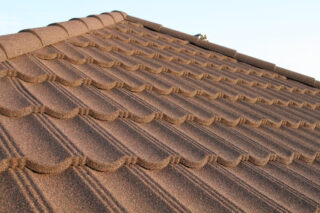
The definition of a composite metal tile implies an imitation of natural ceramics. The material has a grainy surface and is presented in trade organizations in a different color range - monochromatic and gradient models.
Main technical parameters of the material:
- standard length - 1.4 m;
- the width is different for each manufacturer;
- the average leaf area is 0.5 m².
To protect the composite metal tile, the profile is galvanized on both sides with zinc-alumina. Coating composition:
- 55% aluminum - surface corrosion protection;
- 2% silicon - catalyst;
- 43% of zinc is from physical impact.
The layer system also includes an acrylic primer to prevent cracking. Additionally, the sheets are covered with stone granulate made from natural ingredients.
The production of composite metal tiles is subject to the standards of GOST R 58153-2018:
- The strength of the steel sheet is due to the thickness of the metal, which should be no more than 100 microns. Additionally, stone chips give the products reliability.
- A high level of fire resistance is ensured by acrylic-based granules and polymers. Silicon increases the resistance of the alloy to temperatures up to 135 °.
- Aluminum provides excellent flexibility to the material. Due to the composition in the manufacture of the roof, you can make various adjustments to the bends.
- The high level of thermal conductivity is due to the steel at the base of the product. Stone granulate slightly reduces the parameter, but not critical.
The metal tile belongs to environmentally friendly materials, since there are no toxic impurities in it. During operation, no dangerous secretions and poisons occur.
Pros and cons of composite shingles
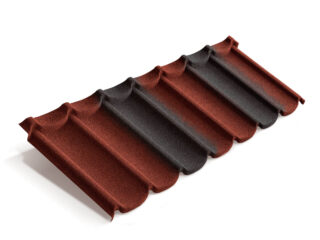
Composite sheets began to be used as a roofing material in the 50s. 20th century. But widespread use began in the 21st century. The advantages of metal tiles are:
- Low weight - up to 6 kg / m² does not require a powerful and expensive rafter system.
- The sustained length of the sheets is 140 cm, which helps to reduce waste.
- Easy installation and no hassle in work.
- Durability and long service life. Top manufacturers provide a 30-50 year warranty period for products.
- The textured surface keeps snow on the roof, preventing precipitation from falling from the building onto the heads of passing people.
Negative factors:
- Low level of vapor permeability due to the use of polymers in the coating composition.
- It is forbidden to break off ice. When clearing snow from a roof, care must be taken not to compromise the integrity of the sheeting.
- The complex production technology and the multilayer structure do not allow the material to be attributed to budget models.Therefore, the products are representatives of the premium segment.
Composite metal tiles are used for arranging roofs with a slope of 12-90 °. A separate product brand is suitable for climatic zones.
Types of composite shingles
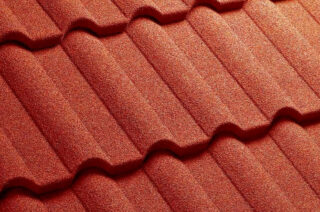
Manufacturers supply different types of composite shingles to the market, where the type of profile plays a major role in aesthetics. Its characteristics also affect functionality and usability.
Types of composite metal tiles:
- Metrotile (Belgium) - steel sheet with a double-sided aluzinc layer. The material is protected against corrosion. Stone chips and acrylic glaze give additional strength to the product. The uniqueness of the product lies in the self-cleaning system.
- Luxard - manufactured from hot dipped galvanized steel. The multilayer structure provides resistance to aggressive environments and high aesthetic performance.
- Gerard - 100% imitation of natural ceramic tiles and cedar cut. The model is available in 12 shades and 7 gradients. The products are based on multilayer coated steel sheets.
- Decra is a frost-resistant, reliable and non-combustible metal tile from the Finnish manufacturer Icopal. The model range includes various shapes and colors.
The high strength profile is suitable for regions with severe frosts, winds and abnormally heavy snows. For other climatic zones, it is important to choose materials that are suitable in terms of technical characteristics and appearance.
Metal tile installation technology
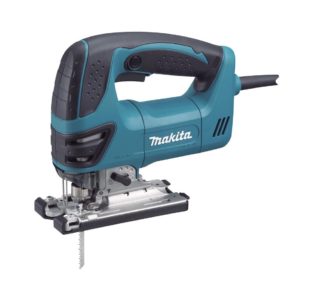
The installation of profiled material is a simple job that even a beginner in the field of roofing installation can handle. To install the shingles, you will need instructions from the manufacturer and equipment.
List of instruments
For laying metal tiles with sprinkles, it is necessary to prepare tools and equipment. The first includes:
- jigsaw;
- hacksaw and scissors for metal;
- a hammer;
- screws;
- circular;
- roulette.
In addition, you will need narrow-profile equipment - a construction guillotine, a mounting gun and a template. Experience is required to work with these tools. In the absence of skills, it is recommended to contact a professional roofer.
Installation Algorithm
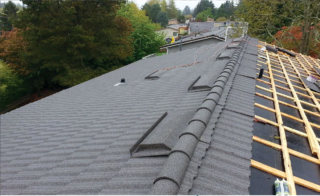
Arrangement of the roof requires a “pie” to be created in advance. The bottom line is the phased installation of hydro, steam and thermal insulation. After these works, the rafter system, counter-lattice and crate are erected. All work is recommended to be carried out in soft shoes to avoid damage to the material.
For roof slopes, the angle of inclination of the composite sheets must be at least 15 °.
Features of installation of metal tiles:
- Sheets start from top to bottom.
- Each subsequent fragment is attached under the previous element with self-tapping screws to the counter-lattice.
- Installation is carried out in a checkerboard pattern. In this case, at the overlap points, it is necessary to combine 3 sheets of material at once.
- Upon completion of the work, the arrangement of the adjoining of the tiles to the technical openings and walls is carried out.
After the measures taken, you need to cut off the protruding elements of the sheets. Places of cuts and heads of fasteners should be coated with a deep penetration primer. If accidental damage to the surface occurs, these areas must be treated with protective compounds and sprinkled with stone chips. After drying, varnish is applied to the surface.








